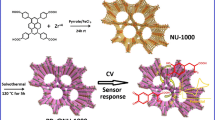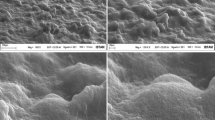Abstract
Herein, a fluorimetric sensor was fabricated based on molecularly imprinted polymers (MIPs) with two types of carbon dots as fluorophores. The MIPs produced had similar excitation wavelengths (400 nm) and different emission wavelengths (445 and 545 nm). They were used for the simultaneous analysis of levodopa and pyridoxine. First, two types of carbon dots, i.e. nitrogen-doped carbon dots (NCDs) with a quantum yield of 43%, and carbon dots from o-phenylenediamine (O-CDs) with a quantum yield of 17%, were prepared using the hydrothermal method. Their surfaces were then covered with MIPs through the reverse microemulsion method. Finally, a mixture of powdered NCD@MIP and O-CD@MIP nanocomposites was used for the simultaneous fluorescence measurement of levodopa and pyridoxine. Under optimal conditions using response surface methodology and Design-Expert software, a linear dynamic range of 38 to 369 nM and 53 to 457 nM, and detection limits of 13 nM and 25 nM were obtained for levodopa and pyridoxine, respectively. The capability of the proposed fluorimetric sensor was investigated in human blood serum and urine samples.

Schematic representation of nitrogen-doped carbon dots (NCDs), carbon dots from o-phenylenediamine (O-CDs), NCDs coated with imprinted polymers (NCD@MIPs), and O-CDs coated with imprinted polymers (O-CD@MIPs) in the presence and absence of levodopa and pyridoxine.





Similar content being viewed by others
References
Huynh TP, Bikram KCC, Lisowski W, et al. Molecularly imprinted polymer of bis(2,2′-bithienyl)methanes for selective determination of adrenaline. Bioelectrochemistry. 2013; 9337–45. https://doi.org/10.1016/j.bioelechem.2012.07.003.
Klawans HL, Ringel SP, Shenker DM. Failure of vitamin B6 to reverse the l-dopa effect in patients on a dopa decarboxylase inhibitor. J Neurol Neurosurg Psychiatry. 1971;34(6):682–6. https://doi.org/10.1136/jnnp.34.6.682.
Kumar PP, Vidyadhara S, Murthy TEGK, et al. Development and validation of RP-HPLC method for simultaneous estimation of Doxylamine succinate and pyridoxine hydrochloride in bulk and pharmaceutical dosage forms. Eurasian J Anal Chem. 2017;12(5):459–68. https://doi.org/10.12973/ejac.2017.00182a.
Brunetti B, Desimoni E. Voltammetric determination of vitamin B6 in food samples and dietary supplements. J Food Compos Anal. 2014;33(2):155–60. https://doi.org/10.1016/j.jfca.2013.12.008.
Rezaei B, Shams-Ghahfarokhi L, Havakeshian E, Ensafi AA. An electrochemical biosensor based on nanoporous stainless steel modified by gold and palladium nanoparticles for simultaneous determination of levodopa and uric acid. Talanta. 2016:15842–50. https://doi.org/10.1016/j.talanta.2016.04.061.
Movlaee K, Beitollahi H, Ganjali MR, Norouzi P. Electrochemical platform for simultaneous determination of levodopa, acetaminophen and tyrosine using a graphene and ferrocene modified carbon paste electrode. Microchim Acta. 2017;184(9):3281–9. https://doi.org/10.1007/s00604-017-2291-3.
Gao X, Yue H, Song S, et al. 3-dimensional hollow graphene balls for voltammetric sensing of levodopa in the presence of uric acid. Microchim Acta. 2018;185(2):91. https://doi.org/10.1007/s00604-017-2644-y.
Shrivas K, Nirmalkar N, Thakur SS, et al. Sucrose capped gold nanoparticles as a plasmonic chemical sensor based on non-covalent interactions: Application for selective detection of vitamins B1 and B6 in brown and white rice food samples. Food Chem. 2018;25014–21.https://doi.org/10.1016/j.foodchem.2018.01.002.
Zhu S, Meng Q, Wang L, et al. Highly photoluminescent carbon dots for multicolor patterning, sensors, and bioimaging. Angew Chemie - Int Ed. 2013;52(14):3953–7. https://doi.org/10.1002/anie.201300519.
Liu G, Chen Z, Jiang X, et al. In-situ hydrothermal synthesis of molecularly imprinted polymers coated carbon dots for fluorescent detection of bisphenol A. Sensors Actuators, B Chem. 2016;228302–307. https://doi.org/10.1016/j.snb.2016.01.010.
Wang N, Wang Y, Guo T, et al. Green preparation of carbon dots with papaya as carbon source for effective fluorescent sensing of Iron (III) and Escherichia coli. Biosens Bioelectron. 2016;8568–75. https://doi.org/10.1016/j.bios.2016.04.089.
Wildgoose GG, Banks CE, Compton RG. Metal nanoparticles and related materials supported on carbon nanotubes: methods and applications. Small. 2006;2(2):182–93. https://doi.org/10.1002/smll.200500324.
Scampicchio M, Wang J, Blasco AJ, et al. Nanoparticle-based assays of antioxidant activity. Anal Chem. 2006;78(6):2060–3. https://doi.org/10.1021/ac052007a.
Sun YP, Zhou B, Lin Y, et al. Quantum-sized carbon dots for bright and colorful photoluminescence. J Am Chem Soc. 2006;128(24):7756–7. https://doi.org/10.1021/ja062677d.
Cai X, Lin M, Tan S, et al. The use of polyethyleneimine-modified reduced graphene oxide as a substrate for silver nanoparticles to produce a material with lower cytotoxicity and long-term antibacterial activity. Carbon N Y. 2012;50(10):3407–15. https://doi.org/10.1016/j.carbon.2012.02.002.
Ding C, Deng Z, Chen J, Jin Y. One-step microwave synthesis of N,S co-doped carbon dots from 1,6-hexanediamine dihydrochloride for cell imaging and ion detection. Colloids Surfaces B Biointerfaces. 2020;189110838. https://doi.org/10.1016/j.colsurfb.2020.110838.
Ling L, Zhu Z, Shen H, et al. One-Step Facile Synthesis of Fluorescent Carbon Dots via Magnetic Hyperthermia Method. Ind Eng Chem Res. 2020;59(11):4968–76. https://doi.org/10.1021/acs.iecr.9b06833.
Li YK, Yang T, Chen ML, Wang JH. Supported carbon dots serve as high-performance adsorbent for the retention of trace cadmium. Talanta. 2018:18018–24. https://doi.org/10.1016/j.talanta.2017.12.020.
Dong Y, Wan L, Cai J, et al. Natural carbon-based dots from humic substances. Sci Rep. 2015;5. https://doi.org/10.1038/srep10037.
Lv P, Xie D, Zhang Z. Magnetic carbon dots based molecularly imprinted polymers for fluorescent detection of bovine hemoglobin. Talanta. 2018:188145–51. https://doi.org/10.1016/j.talanta.2018.05.068.
Wang HF, He Y, Ji TR, Yan XP. Surface molecular imprinting on Mn-doped ZnS quantum dots for room-temperature phosphorescence optosensing of pentachlorophenol in water. Anal Chem. 2009;81(4):1615–21. https://doi.org/10.1021/ac802375a.
Zhou X, Gao X, Liu M, et al. A poly(5-indolylboronic acid) based molecular imprint doped with carbon dots for fluorometric determination of glucose. Microchim Acta. 2017;184(10):4175–81. https://doi.org/10.1007/s00604-017-2448-0.
Ensafi AA, Kazemifard N, Rezaei B. Development of a selective prilocaine optical sensor based on molecularly imprinted shell on CdTe quantum dots. Sensors Actuators B Chem. 2017:242835–41. https://doi.org/10.1016/j.snb.2016.09.175.
Dabrowski M, Lach P, Cieplak M, Kutner W. Nanostructured molecularly imprinted polymers for protein chemosensing. Biosens Bioelectron. 2018:10217–26. https://doi.org/10.1016/j.bios.2017.10.045.
Díaz-García ME, Fernández-González A. Molecularly Imprinted Polymers. In: Encyclopedia of Analytical Science: Second Edition. Elsevier, 2004;172–182. https://doi.org/10.1016/B0-12-369397-7/00700-7
Hao T, Wei X, Nie Y, et al. An eco-friendly molecularly imprinted fluorescence composite material based on carbon dots for fluorescent detection of 4-nitrophenol. Microchim Acta. 2016;183(7):2197–203. https://doi.org/10.1007/s00604-016-1851-2.
Zhang Y, He YH, Cui PP, et al. Water-soluble, nitrogen-doped fluorescent carbon dots for highly sensitive and selective detection of Hg2+ in aqueous solution. RSC Adv. 2015;5(50):40393–401. https://doi.org/10.1039/c5ra04653j.
Jiang K, Sun S, Zhang L, et al. Red, green, and blue luminescence by carbon dots: full-color emission tuning and multicolor cellular imaging. Angew Chemie - Int Ed. 2015;54(18):5360–3. https://doi.org/10.1002/anie.201501193.
Ma Y, Chen X, Bai J, et al. Highly selective fluorescence chemosensor based on carbon-dot-aerogel for detection of aniline gas. Inorg Chem Commun. 2019;10064–69. https://doi.org/10.1016/j.inoche.2018.12.013.
Pichon V, Chapuis-Hugon F. Role of molecularly imprinted polymers for selective determination of environmental pollutants—a review. Anal Chim Acta. 2008;622(1–2):48–61. https://doi.org/10.1016/j.aca.2008.05.057.
Amjadi M, Jalili R. Molecularly imprinted mesoporous silica embedded with carbon dots and semiconductor quantum dots as a ratiometric fluorescent sensor for diniconazole. Biosens Bioelectron. 2017:96121–6. https://doi.org/10.1016/j.bios.2017.04.045.
Ensafi AA, Nasr-Esfahani P, Rezaei B. Synthesis of molecularly imprinted polymer on carbon quantum dots as an optical sensor for selective fluorescent determination of promethazine hydrochloride. Sensors Actuators B Chem. 2018:257889–96. https://doi.org/10.1016/j.snb.2017.11.050.
Zhao GJ, Liu JY, Zhou LC, Han KL. Site-selective photoinduced electron transfer from alcoholic solvents to the chromophore facilitated by hydrogen bonding: a new fluorescence quenching mechanism. J Phys Chem B. 2007;111(30):8940–5. https://doi.org/10.1021/jp0734530.
Ghali M. Static quenching of bovine serum albumin conjugated with small size CdS nanocrystalline quantum dots. J Lumin. 2010;130(7):1254–7. https://doi.org/10.1016/j.jlumin.2010.02.034.
Zu F, Yan F, Bai Z, et al. The quenching of the fluorescence of carbon dots: a review on mechanisms and applications. Microchim Acta. 2017;184(7):1899–914. https://doi.org/10.1007/s00604-017-2318-9.
Stobiecka M, Chalupa A. Modulation of plasmon-enhanced resonance energy transfer to gold nanoparticles by protein Survivin channeled-Shell gating. J Phys Chem B. 2015;119(41):13227–35. https://doi.org/10.1021/acs.jpcb.5b07778.
Baião V, Tomé LIN, Brett CMA. Iron oxide nanoparticle and multiwalled carbon nanotube modified glassy carbon electrodes. Application to levodopa detection. Electroanalysis. 2018;30(7):1342–8. https://doi.org/10.1002/elan.201700854.
Kul D, Brett CMA. Electrochemical investigation and determination of levodopa on poly(Nile blue-a)/multiwalled carbon nanotube modified glassy carbon electrodes. Electroanalysis. 2014;26(6):1320–5. https://doi.org/10.1002/elan.201400071.
Yue HY, Zhang H, Huang S, et al. Synthesis of ZnO nanowire arrays/3D graphene foam and application for determination of levodopa in the presence of uric acid. Biosens Bioelectron. 2017;89592–597. https://doi.org/10.1016/j.bios.2016.01.078.
Beitollahi H, Salimi H, Ganjali MR. Selective determination of levodopa in the presence of vitamin B 6, theophylline and guaifenesin using a glassy carbon electrode modified with a composite of hematoxylin and graphene/ZnO. Anal Sci. 2018;34(8):867–73. https://doi.org/10.2116/analsci.17P526.
Chen C, Zou C, Li L, et al. Blue and green emission-transformed fluorescent copolymer: Specific detection of levodopa of anti-Parkinson drug in human serum. Talanta. 2020;214120817. https://doi.org/10.1016/j.talanta.2020.120817.
Hu M, Yu H, Wei F, et al. Citrate-capped Mn-modified CdSe/CdS quantum dots as luminescent probes for levodopa detection in aqueous solution. Spectrochim Acta - Part A Mol Biomol Spectrosc. 2012;91130–135. https://doi.org/10.1016/j.saa.2012.01.081.
Moslehipour A, Bigdeli A, Ghasemi F, Hormozi-Nezhad MR. Design of a ratiometric fluorescence nanoprobe to detect plasma levels of levodopa. Microchem J. 2019:148591–6. https://doi.org/10.1016/j.microc.2019.05.041.
Gonzalez-Rodriguez J, Sevilla JM, Pineda T, Blazquez M. Electrochemical analysis on compounds of the vitamin B6 family using glassy carbon electrodes. Int J Electrochem Sci. 2012;7(3):2221–9.
Llorent-Martínez EJ, García-Reyes JF, Ortega-Barrales P, Molina-Díaz A. A multicommuted fluorescence-based sensing system for simultaneous determination of vitamins B2 and B6. Anal Chim Acta. 2006;555(1):128–33. https://doi.org/10.1016/j.aca.2005.08.054.
Zobeiri E, Bayandori Moghaddam A, Gudarzy F, et al. Modified Eu-doped Y2O3 nanoparticles as turn-off luminescent probes for the sensitive detection of pyridoxine. Luminescence. 2015;30(3):290–5. https://doi.org/10.1002/bio.2727.
Wang RY, Wu J, Wang LJ, et al. CdTe quantum dots as fluorescence sensor for the determination of aminophylline in aqueous solution. Opt Spectrosc (English Transl Opt i Spektrosk). 2013;115(4):596–600. https://doi.org/10.1134/S0030400X13100147.
Escandar GM, Bystol AJ, Campiglia AD. Spectrofluorimetric method for the determination of piroxicam and pyridoxine. Anal Chim Acta. 2002;466(2):275–83. https://doi.org/10.1016/S0003-2670(02)00595-0.
Acknowledgements
We wish to thank Isfahan University of Technology (IUT) Research Council and Center of Excellence in Sensor and Green Chemistry for their patronage and help in this study.
Author information
Authors and Affiliations
Corresponding author
Ethics declarations
Conflict of interest
The authors declare that they have no conflict of interest.
Ethical approval
All procedures performed in studies involving human samples were in accordance with the ethical standards of the institutional research committee of Isfahan University of Technology and with the 1964 Helsinki declaration and its later amendments or comparable ethical standards.
Permissions
The management of the Health Center of Isfahan University of Technology has authorized the use of blood and urine samples in this study, and the publication of the results of the study of the mentioned samples has no conflict of interest.
Additional information
Publisher’s note
Springer Nature remains neutral with regard to jurisdictional claims in published maps and institutional affiliations.
Electronic supplementary material
ESM 1
(PDF 1868 kb)
Rights and permissions
About this article
Cite this article
Ghani, S.M., Rezaei, B., Jamei, H.R. et al. Novel synthesis of a dual fluorimetric sensor for the simultaneous analysis of levodopa and pyridoxine. Anal Bioanal Chem 413, 377–387 (2021). https://doi.org/10.1007/s00216-020-03005-9
Received:
Revised:
Accepted:
Published:
Issue Date:
DOI: https://doi.org/10.1007/s00216-020-03005-9




